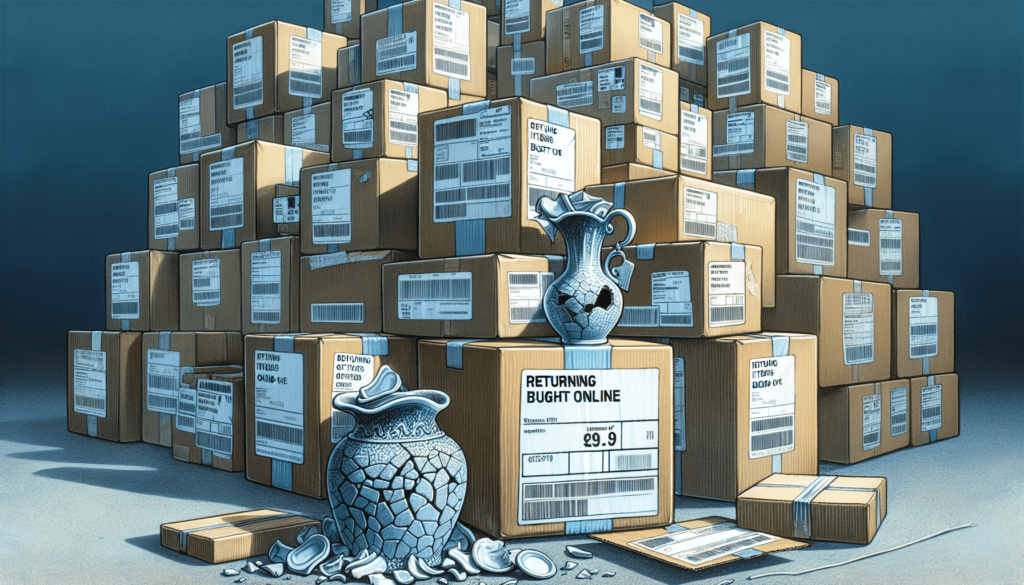Have you ever found yourself in the awkward predicament of having to return perishable items? Whether it’s a spoiled batch of groceries or a wilted bouquet of flowers, figuring out the process for returning such items can be quite daunting. But fear not! In this article, we will provide you with some valuable insights on special return circumstances and offer practical tips for returning perishable items. So next time you’re faced with the dilemma of dealing with spoiled goods, you’ll be well-informed and equipped to handle the situation with ease.
Overview
Definition of Perishable Items
Perishable items are goods that have a limited shelf life and are prone to spoilage or decay if not properly stored or consumed within a certain timeframe. These items are typically fresh food products, such as fruits, vegetables, dairy products, meat, and seafood. However, perishable items can also include other products that require specific temperature or storage conditions, such as medications or certain beauty and cosmetic products.
Importance of Properly Returning Perishable Items
Properly returning perishable items is essential for several reasons. Firstly, it ensures that consumers receive their money’s worth by either obtaining a refund or a replacement for spoiled or unsatisfactory products. Secondly, it helps maintain the quality and safety standards of retailers and manufacturers, as returning perishable items provides valuable feedback about the condition or defects of the products. Lastly, responsible returns of perishable items contribute to reducing food waste and promote sustainable consumption practices.
Common Perishable Items
Perishable items encompass a wide range of products commonly found in households and grocery stores. Some of the most common perishable items include fresh produce like fruits and vegetables, dairy products such as milk, cheese, and yogurt, meats and poultry, seafood, baked goods, and prepared meals. It is important to note that the perishability of certain items varies, and it is crucial to pay attention to expiration dates and storage guidelines to ensure their freshness and safety. Understanding Return Policies
General Return Policies
Every retailer has its own return policy, so it is essential to familiarize yourself with the terms and conditions specific to each store. Generally, return policies specify the timeframe within which returns are accepted, the condition in which the item should be returned, and the possible options for refund or exchange. It is important to read and understand these policies before initiating a return, as failing to comply with them may affect your eligibility for reimbursement or replacement.
Specific Policies for Perishable Items
Given the nature of perishable items, return policies for these products may differ from those applied to non-perishable items. Retailers often have specific guidelines for returning perishable items due to their limited shelf life. Some may require returns to be made within a shorter timeframe, while others may impose additional conditions regarding the condition or packaging of the items. It is crucial to review these policies and comply with any necessary requirements to ensure a smooth return process.
Expiry Date Considerations
One of the key factors to consider when returning perishable items is the expiration date. It is vital to check the expiry date of a product before making a purchase and to verify that it is within an acceptable timeframe. If you discover that the item has expired or will expire soon after purchase, it is advisable to return it promptly. Keep in mind that returning an item close to or after its expiry date may affect your eligibility for a refund or replacement. Therefore, being proactive in checking expiry dates can help you avoid potential issues when returning perishable items.
Preparing for Perishable Item Returns

Gather Required Documentation
Before returning perishable items, it is important to gather all the necessary documentation to facilitate the process. This typically includes the original purchase receipt or proof of purchase, as well as any additional documentation specified by the retailer. Having this documentation readily available will help expedite the return and ensure that you have the required information to process the refund or exchange smoothly.
Packaging and Storage Guidelines
To ensure the safe return of perishable items, it is crucial to follow packaging and storage guidelines provided by the retailer or manufacturer. Proper packaging helps maintain the quality and integrity of the product during transportation and prevents further spoilage or contamination. This may include using insulated packaging materials, such as coolers or ice packs, to maintain the appropriate temperature for items that require it. Additionally, following storage guidelines, such as refrigerating or freezing the items as instructed, will help preserve their freshness until they can be returned.
Handling Temperature-Sensitive Items
Certain perishable items, such as medications or beauty products, may require specific temperature control during transportation. If you need to return temperature-sensitive items, it is important to take precautions to protect their quality and efficacy. This may involve using insulated packaging materials, selecting appropriate shipping methods that offer temperature control, and availing yourself of special services provided by courier companies for perishable goods. By paying attention to temperature sensitivity, you can ensure the safety and integrity of these items during the return process.
Returning Perishable Items by Mail
Choosing an Appropriate Shipping Method
When returning perishable items by mail, selecting the right shipping method is crucial to ensure the items’ preservation and timely delivery. Consider using expedited shipping services that offer faster transit times to minimize the time the items spend outside of proper storage conditions. Additionally, explore shipping options that provide temperature control, such as refrigerated or frozen shipping capabilities, depending on the perishable items being returned. Choosing an appropriate shipping method greatly reduces the risk of spoilage or degradation during transit.
Insulating and Securing Packages
Proper insulation and secure packaging are essential to safeguard perishable items during shipping. Use suitable insulated packaging materials, such as foam coolers or thermal bubble wrap, to maintain the appropriate temperature for the items. Securely seal the package to prevent leaks or spills that could damage other items during transit. Additionally, consider using sturdy and durable packaging materials to protect the perishable items from rough handling or accidental damage.
Notifying the Carrier of Perishable Contents
When shipping perishable items, it is important to inform the carrier about the contents of the package. This enables them to handle the shipment appropriately and prioritize its delivery to minimize the time the items spend outside of proper storage conditions. Some carriers may have specific procedures or requirements for shipping perishable items, so it is recommended to check with the carrier in advance to ensure compliance and prevent any potential issues during the return process.

Tracking and Insurance Options
To ensure the transparency and security of your perishable item return, utilize tracking and insurance options provided by the shipping carrier. Tracking allows you to monitor the progress of your package, ensuring its timely arrival and providing peace of mind throughout the return process. Insurance protects your items against loss or damage during transit, providing financial reimbursement in the event of an unfortunate incident. These options provide valuable protection and give you the confidence that your perishable items will be returned safely.
Returning Perishable Items In-Person
Identifying Authorized Return Locations
When opting to return perishable items in-person, it is important to identify the authorized return locations of the retailer. These locations can vary and may include physical stores, collection points, or authorized dealers. Prioritize returning the items to the designated locations specified by the retailer to ensure a smooth and efficient return process. Identifying the authorized return locations also allows you to seek assistance from store personnel if needed, as they are familiar with the retailer’s return policies and procedures.
Bringing Proper Packaging and Documentation
To facilitate the in-person return of perishable items, bring along the proper packaging and documentation required by the retailer. This includes the original purchase receipt or proof of purchase, any additional documents requested by the retailer, and the appropriate packaging materials if necessary. By being prepared with the required documentation and packaging, you can streamline the return process and minimize any potential delays or complications.
Coordinating Returns with Store Personnel
When returning perishable items in-person, it can be helpful to coordinate with store personnel to ensure a smooth experience. Seek assistance from customer service or the returns department to understand the specific procedures for returning perishable items at the store. They can guide you through the return process, answer any questions or concerns you may have, and help expedite the refund or exchange. Collaborating with store personnel ensures that you receive the necessary support and expertise during your in-person return.
Exceptions and Restrictions on Perishable Item Returns
Non-Returnable Perishable Items
While many retailers accept returns of perishable items, there may be exceptions or restrictions on certain products. For example, items that have been opened, consumed, or used may not be eligible for return due to health and safety regulations. Similarly, perishable items that were discounted or purchased as clearance items may have different return policies. It is important to review the retailer’s return policy or contact customer support to clarify the eligibility of particular perishable items for return before initiating the process.
Partial Returns of Perishable Items
In some cases, it may be possible to return a portion of a perishable item instead of the entire product. This is particularly relevant in situations where only a portion of the item is spoiled or unsatisfactory. However, not all retailers may allow partial returns, so it is important to review the return policy or contact customer support to determine the feasibility of returning a portion of a perishable item. Keep in mind that the refund or exchange value may be adjusted based on the returned quantity.

Returns During Specific Time Windows
Certain retailers may impose time restrictions on returning perishable items. This can be in the form of a limited return window or specific return hours for perishable products. It is important to be aware of these time constraints and plan your return accordingly to avoid missing the deadline or encountering any challenges. If returning perishable items during certain time windows is inconvenient, consider alternative return methods such as mail-in returns, if permitted by the retailer.
Receiving Refunds or Exchanges
Store Credit vs. Cash Refunds
Depending on the retailer’s policy, you may be offered a choice between store credit or a cash refund when returning perishable items. Store credit allows you to utilize the refunded value towards future purchases within the same retailer, while a cash refund provides immediate reimbursement. Consider your personal preferences and needs when deciding on the type of refund. Keep in mind that store credit may offer additional benefits, such as loyalty rewards or promotional discounts, which can enhance your future shopping experience.
Refund Processing Timeframes
The time it takes to receive a refund for returned perishable items can vary depending on the retailer and the payment method used for the original purchase. In general, refunds are processed within a few business days of the return being accepted by the retailer. However, it is important to note that the refund might not appear immediately on your account due to interbank transfer times or processing delays. If you have concerns about the refund processing timeframe, it is advisable to contact customer support for clarification and assistance.
Exchange Policies for Perishable Items
In addition to refunds, some retailers may offer the option to exchange perishable items for a different product. This allows you to choose an alternative item of equal or lesser value in place of the originally purchased item. However, exchange policies may have certain restrictions or conditions, such as limited availability of alternative products or exclusions on specific perishable items. It is recommended to review the retailer’s exchange policy or contact customer support to understand the options available for your perishable item return.
Addressing Quality or Safety Concerns
Documenting Product Defects or Spoilage
If you encounter quality or safety concerns with perishable items, it is crucial to document the defects or spoilage. Take clear photographs or videos that demonstrate the issue, showing details such as mold, discoloration, leaks, or any other visible signs of deterioration. This visual evidence can be valuable when communicating with customer support or seeking replacements or compensation. Documentation serves as proof of the item’s condition and helps support your claim for a refund or exchange.
Contacting Customer Support
When facing quality or safety concerns with perishable items, it is important to contact customer support promptly. Reach out to the retailer through their designated communication channels, such as phone, email, or live chat, and provide them with a detailed description of the issue you encountered. Include relevant information such as the product name, purchase date, and any supporting documentation. Customer support will guide you through the necessary steps to address your concerns and find a suitable resolution.
Requesting Replacements or Compensation
If you have received perishable items that are defective, spoiled, or unsafe, you may be entitled to replacements or compensation. After contacting customer support and providing the necessary information and documentation, inquire about the options available to rectify the situation. This may include receiving a replacement item, obtaining a refund or store credit, or being compensated for any damages incurred. Retailers understand the importance of customer satisfaction and will work to address your concerns with perishable items in a fair and satisfactory manner.
Responsible Consumer Practices
Minimizing Perishable Item Returns
To minimize the need for returning perishable items, it is important to practice responsible consumer habits. Ensure that you are purchasing perishable items with a realistic consumption timeline and that you have suitable storage conditions available. While shopping, pay attention to expiration dates, select products with the furthest expiration dates, and avoid bulk purchases that may result in wastage. By practicing mindful shopping and consumption, you can minimize the need for returns and contribute to reducing food waste.
Donating Perishable Items
In cases where perishable items cannot be returned or are not eligible for a refund, consider donating them to local charities or organizations that accept perishable food donations. Many food banks or shelters welcome donations of fresh produce, dairy products, and other perishable items that are still safe for consumption. Donating perishable items not only helps those in need but also ensures that the products are put to good use instead of going to waste. Prioritize contacting local organizations to understand their acceptance guidelines and arrange for the donation accordingly.
Properly Disposing of Perishable Items
If returning or donating perishable items is not possible, it is important to dispose of them properly. Improper disposal of perishable items can lead to environmental contamination and health hazards. Follow local waste management guidelines for the proper disposal of perishable items, which may involve using designated compost bins, organic waste disposal services, or other appropriate methods. By disposing of perishable items responsibly, you contribute to a cleaner and healthier environment.
Additional Considerations
Legal Rights for Perishable Item Returns
Consumer protection laws differ from country to country and may include provisions specifically addressing the return of perishable items. Familiarize yourself with the legal rights and regulations governing returns in your jurisdiction to understand your entitlements and the retailer’s obligations. These laws often establish a baseline for acceptable return policies and provide recourse in the case of unreasonably restrictive or unfair practices regarding perishable item returns.
Third-Party Selling Platforms
When purchasing perishable items from third-party selling platforms, it is important to review the platform’s policies regarding returns and refunds. Third-party sellers may have their own return policies that differ from the platform’s general policies. Take the time to read and understand the terms and conditions of each seller before making a purchase to ensure clarity on returning perishable items or seeking refunds if necessary.
Issues with International Returns
Returning perishable items internationally can present additional challenges due to customs regulations, transportation logistics, and temperature control. It is advisable to consult with the retailer or shipping carrier before initiating an international return to understand any specific requirements or restrictions. When returning perishable items internationally, consider using expedited shipping methods and ensure compliance with customs regulations to expedite the return process and minimize the risk of spoilage.
In conclusion, properly returning perishable items is essential for both consumers and retailers. Understanding return policies, following guidelines for packaging and storage, and selecting appropriate shipping methods are crucial steps to ensure successful returns by mail. When returning items in-person, identifying authorized return locations, bringing proper documentation, and coordinating with store personnel streamline the process. It is important to be aware of exceptions, such as non-returnable items or time windows for returns. Receiving refunds or exchanges requires familiarity with the available options and understanding refund processing timeframes. Addressing quality or safety concerns involves documenting defects, contacting customer support, and requesting suitable remedies. Practicing responsible consumer habits such as minimizing returns, donating perishable items, and properly disposing of them contributes to sustainable consumption. Finally, understanding legal rights, considering third-party selling platforms, and being mindful of international returns provide comprehensive guidance for returning perishable items.




